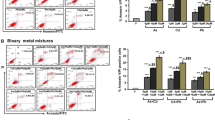Abstract
Objective
To observe the effects of lead on levels of phosphorylated extracellular signal regulated kinase (p-ERK) in the cytoplasm of primary cultures of rat astroglial cells and the possible protective effect of basic fibroblast growth factor (bFGF) on lead-induced effects.
Methods
The primary astroglia cells from 1∼6 d old Wistar rats were cultured. The cells pretreated with the MEK1 (mitogen-activated protein kinase kinase 1) inhibitor PD98059 and bFGF, respectively, were exposed to Pb acetate of different concentrations for different times. Western blotting and reverse transcription polymerase chain reaction (RT-PCR) methods were used to detect the protein and mRNA expressions of ERK.
Results
mRNA expression for ERK peaked 15 min after initiation of lead exposure (P<0.05) and protein expression of p-ERK peaked at 30 min (P<0.05). ERK mRNA levels and p-ERK protein levels returned to baseline after 60 and 120 min of lead exposure, respectively (P>0.05). The increase in p-ERK levels in lead-treated cells could be inhibited by PD098059. Activation of ERK in the cells by lead was prevented by pretreatment with bFGF. Total ERK protein levels did not change under the same experimental conditions (P>0.05).
Conclusion
Low-level lead exposure resulted in transient activation of ERK through the MEK pathway, which then returned to basal levels in the continued presence of lead. Exogenous bFGF protected ERK signaling components in astroglia from lead poisoning.
Similar content being viewed by others
References
Adams, J.P., Sweatt, J.D., 2002. Molecular psychology: roles for the ERK MAP kinase cascade in memory. Annu. Rev. Pharmacol. Toxicol., 42(1):135–163. [doi:10.1146/annurev.pharmtox.42.082701.145401]
Basilico, C., Moscatelli, D., 1992. The FGF family of growth factors and oncogenes. Adv. Cancer Res., 59:115–165.
Bradbury, M.W., Deane, R., 1993. Permeability of the blood-brain barrier to lead. Neurotoxicology, 14(2–3):131–136.
Chang, L., Karin, M., 2001. Mammalian MAP kinase signaling cascades. Nature, 410(6824):37–40. [doi:10.1038/35065000]
Cui, Y., Zhu, Y.G., Zhai, R., Huang, Y., Qiu, Y., Liang, J., 2005. Exposure to metal mixtures and human health impacts in a contaminated area in Nanning, China. Environ. Int., 31(6):784–790. [doi:10.1016/j.envint.2005.05.025]
Dhandapani, K.M., Khan, M.M., Wade, F.M., Wakade, C., Mahesh, V.B., Brann, D.W., 2007. Induction of transforming growth factor-beta1 by basic fibroblast growth factor in rat C6 glioma cells and astrocytes is mediated by MEK/ERK signaling and AP-1 activation. J. Neurosci. Res., 85(5):1033–1045. [doi:10.1002/jnr.21182]
Ensoli, B., Markham, P., Kao, V., Barillari, G., Fiorelli, V., Gendelman, R., Raffeld, M., Zon, G., Gallo, R.C., 1994. Block of AIDS-Kaposi’s sarcoma (KS) cell growth, angiogenesis, and lesion formation in nude mice by antisense oligonudeotide targeting basic fibroblast growth factor. A novel strategy for the therapy of KS. J. Clin. Invest., 94(5):1736–1746.
Exkenstien, F.P., 1994. Fibroblast growth factors in the nervous system. J. Neurobio., 25(11):1467–1480. [doi:10.1002/neu.480251112]
Kanterewicz, B.I., Urban, N.N., McMahon, D.B., Norman, E.D., Giffen, L.J., Favata, M.F., Scherle, P.A., Trzskos, J.M., Barrionuevo, G., Klann, E., 2000. The extracellular signal regulated kinase cascade is required for NMDA receptor in dependent LTP in area CA1 but not area CA3 of the hippocampus. J. Neurosci., 20(9):3057–3066.
Kolch, W., 2000. Meaningful relationships: the regulation of the Ras/Raf/MEK/ERK pathway by protein interactions. Biochem. J., 351(2):289–305. [doi:10.1042/0264-6021:3510289]
Lin, Y.W., Chuang, S.M., Yang, J.L., 2003. Persistent activation of ERK1/2 by lead acetate increases nucleotide excision repair synthesis and confers anti-cytotoxicity and anti-mutagenicity. Carcinogenesis, 24(1):53–61. [doi:10.1093/carcin/24.1.53]
Lindahl, L.S., Bird, L., Legare, M.E., Mikeska, G., Bratton, G.R., Tiffany-Castiglioni, E., 1999. Differential ability of astroglia and neuronal cells to accumulate lead: dependence on cell type and on degree of differentiation. Toxicol. Sci., 50(2):236–243. [doi:10.1093/toxsci/50.2.236]
Mir, A.H., Christopher, M.L.B., Jonathan, P., John, L., 2000. Induction of vascular endothelial growth factor in human astrocytes by lead. J. Biol. Chem., 275(36):27874–27882.
Neben, K., Moehler, T., Egerer, G., Kraemer, A., Hillengass, J., Benner, A., Ho, A.D., Goldschmidt, H., 2001. High plasma basic fibroblast growth factor concentration is associated with response to thalidomide in progressive multiple myeloma. Clin. Cancer Res., 7(9):2675–2681.
Nebreda, A.R., Porras, A., 2000. p38 MAP kinases: beyond the stressresponse. Trends Biochem. Sci., 25(6):257–260. [doi:10.1016/S0968-0004(00)01595-4]
Qian, Y., Harris, E.D., Zheng, Y., Tiffany-Castiglioni, E., 2000. Lead targets GRP78, a molecular chaperone, in C6 rat glioma cells. Toxicol. Appl. Pharmacol., 163(3):260–266. [doi:10.1006/taap.1999.8878]
Sierra, E.M., Tiffany-Castiglioni, E., 1991. Reduction of glutamine synthetase activity in astroglia exposed in culture to low levels of inorganic lead. Toxicology, 65(3):295–304. [doi:10.1016/0300-483X(91)90088-I]
Spence, J.R., Madhavan, M., Aycinena, J.C., Del Rio-Tsonis, K., 2007. Retina regeneration in the chick embryo is not induced by spontaneous Mitf downregulation but requires FGF/FGFR/MEK/Erk dependent upregulation of Pax6. Mol. Vis., 24(13):57–65.
Suresh, C., Dennis, A.O., Heinz, J., Vemuri, M.C., Chetty, C.S., 2006. Melatonin protection against lead-induced changes in human neruoblastoma cell cultures. Int. J. Toxicol., 25(6):459–464. [doi:10.1080/10915810600959576]
Tiffany-Castiglioni, E., 1993. Cell culture models for lead toxicity in neuronal and glial cells. Neurotoxicology, 14(4):513–536.
Whitmarsh, A.J., Davis, R.J., 2000. Regulation of transcription factor function by phosphorylation. Cell. Mol. Life Sci., 57(8–9):1172–1183. [doi:10.1007/PL00000757]
Zhu, Z.W., Yang, R.L., Dong, G.J., Zhao, Z.Y., 2005. Study on the neurotoxic effects of low-level lead exposure in rats. J. Zhejiang Univ. Sci. B, 6(7):686–692. [doi:10.1631/jzus.2005.B0686]
Author information
Authors and Affiliations
Corresponding author
Additional information
Project (No. 39970651) supported by the National Natural Science Foundation of China
Rights and permissions
About this article
Cite this article
Zhang, Y., Ye, Lp., Wang, B. et al. Effect of lead on ERK activity and the protective function of bFGF in rat primary culture astroglia. J. Zhejiang Univ. - Sci. B 8, 422–427 (2007). https://doi.org/10.1631/jzus.2007.B0422
Received:
Accepted:
Issue Date:
DOI: https://doi.org/10.1631/jzus.2007.B0422




